
Unitarian Universalism (UU) is a liberal religion characterized by a "free and responsible search for truth and meaning". Unitarian Universalists assert no creed, but instead are unified by their shared search for spiritual growth, guided by a dynamic, "living tradition". Currently, these traditions are summarized by the Six Sources and Seven Principles of Unitarian Universalism, documents recognized by all congregations who choose to be a part of the Unitarian Universalist Association. These documents are 'living', meaning always open for revisiting and reworking. Unitarian Universalist (U.U.) congregations include many atheists, agnostics, and theists within their membership. There are U.U. churches, fellowships, congregations, and societies around the world. The roots of Unitarian Universalism lie in protestant liberal Christianity, specifically unitarianism and universalism. Unitarian Universalists state that from these traditions comes a deep regard for intellectual freedom and inclusive love. Congregations and members seek inspiration and derive insight from all major world religions.
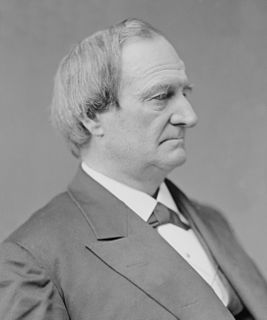
Alphonso Taft was an American jurist, diplomat, politician, Attorney General and Secretary of War under President Ulysses S. Grant. He was also the founder of the Taft political dynasty, and father of President and Chief Justice William Howard Taft.

The First Unitarian Church of Rochester is located at 220 Winton Road South in Rochester, New York, U.S. The congregation is one of the largest in its denomination, the Unitarian Universalist Association. The non-creedal church conducts programs in the areas of spirituality, social concerns, music, and arts. This church is one of two Unitarian Universalist congregations in Monroe County, the other being First Universalist Church of Rochester.
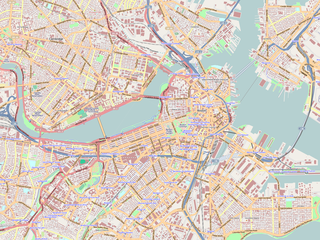
The Arlington Street Church is a Unitarian Universalist church across from the Public Garden in Boston, Massachusetts. Because of its geographic prominence and the notable ministers who have served the congregation, the church is considered to be among the most historically important in American Unitarianism and Unitarian Universalism. Completed in 1861, it was designed by Arthur Gilman and Gridley James Fox Bryant to resemble James Gibbs' St. Martin-in-the-Fields in London. The main sanctuary space has 16 large-scale stained-glass windows installed by Tiffany Studios from 1899 to 1930.

The First Unitarian Society of Madison (FUS) is a Unitarian Universalist congregation in Shorewood Hills, Wisconsin. Its meeting house was designed by Frank Lloyd Wright and built by Marshall Erdman in 1949–1951, and has been designated a U.S. National Historic Landmark for its architecture. With over 1,000 members, it is one of the ten largest Unitarian Universalist congregations in the United States.

All Souls Church, Unitarian is a Unitarian Universalist church located at 1500 Harvard Street NW at the intersection of 16th Street, Washington, D.C., roughly where the Mt. Pleasant, Columbia Heights, and Adams Morgan neighborhoods of the city meet. The design of its current building, completed in 1924, is based on St. Martin's-in-the-Fields in London. It was listed on the National Register of Historic Places in 2020. All Souls, a member of the Unitarian Universalist Association of Congregations, describes its theology as having evolved from a liberal Christian tradition into a "rich pluralism."
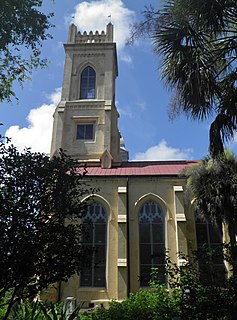
The Unitarian Church in Charleston, home to a Unitarian Universalist congregation, is an historic church located at 4 Archdale Street in Charleston, South Carolina. It is the oldest Unitarian church in the South and the second oldest church building on the peninsula of Charleston.

The Unitarian Church of All Souls at 1157 Lexington Avenue at East 80th Street in the Upper East Side of Manhattan, New York City was built in 1932 and was designed by Hobart Upjohn – Richard Upjohn's grandson – in the Neo-colonial style with a Regency-influenced brick base. It is the congregation's fourth sanctuary. The congregation, dating back to 1819, was the first Unitarian Universalist congregation in the city. It has provided a pulpit for some of the movement's leading theologians and has also recorded many eminent persons in its membership.

The Unitarian Universalist Church of Medford and The Osgood House are a historic Unitarian Universalist church building and parsonage house at 141 and 147 High Street in Medford, Massachusetts.

First Parish Church in Plymouth is a historic Unitarian Universalist church at the base of Burial Hill on the town square off Leyden Street in Plymouth, Massachusetts. The congregation was founded in 1620 by the Pilgrims in Plymouth. The current building was constructed in 1899.

South Parish is the historic name of a church at 292 State Street in Portsmouth, New Hampshire, in the United States. The church building, built in 1824-26, is one of the earliest examples of Classical Revival architecture in New England, and was listed on the National Register of Historic Places in 1979.

The First Congregational Church of Oregon City, also known as Atkinson Memorial Congregational Church, is a historic building located at 6th and John Adams Sts. in Oregon City, Oregon. The congregation was formed in 1844 as a non-denominational Protestant congregation. In 1892 they affiliated with the Congregational Christian Church from the local Congregational Society that had been formed in 1849 from the 1844 congregation. The present building was constructed in the Gothic Revival style in 1925 after the previous building had been destroyed in a fire in 1923. It was listed on the National Register of Historic Places in 1982.

The Unitarian Universalist Church is a historic church building at 100 N. State Street in Ann Arbor, Michigan. It was listed on the National Register of Historic Places in 1978.
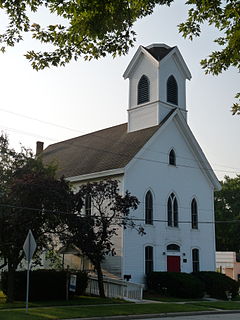
The United Unitarian and Universalist Church in Mukwonago, Wisconsin is a Victorian Gothic-styled church and meeting hall built in 1878 - the only Yankee-built church remaining in the town. In 1987 it was added to the National Register of Historic Places for its significance in architecture and social history.

Underbank Chapel is a Unitarian place of worship in Stannington, a suburb of Sheffield, South Yorkshire. It is a member of the General Assembly of Unitarian and Free Christian Churches, the umbrella organisation for British Unitarians.

The Housatonic Congregational Church is a historic church building at 1089 Main Street in Great Barrington, Massachusetts. Built in 1892 it is a prominent local example of Queen Anne Revival architecture, and was listed on the National Register of Historic Places in 2002. It is now home to the Unitarian Universalist Meeting of South Berkshire.
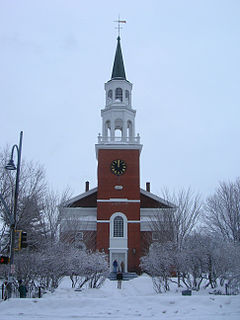
Built in 1816, the Unitarian Universalist Meeting House is the oldest remaining place of worship established by white settlers in Burlington, Vermont. It is located along the northern side of the intersection of Pearl Street and the Church Street Marketplace.

Church of Our Father was the first Unitarian church established in Atlanta, Georgia. The church was organized on March 27, 1883, by Rev. George Leonard Chaney, a Boston minister. Rev. Chaney initially held Sunday services in the Senate Chamber, Concordia Hall and the United States Courtroom. A church building was constructed at the corner of North Forsyth and Church Street and dedicated on April 23, 1884. The original building was demolished in 1900.

Northwest Unitarian Universalist Congregation (Northwest) was organized in 1969. The organization of Northwest was the result of action taken by the Unitarian Universalist Congregation of Atlanta (UUCA) to establish a new congregation in the northwest suburbs of Atlanta.

The Unitarian Universalist Church of Lancaster is a Unitarian Universalist church located at 538 West Chestnut Street, Lancaster, Pennsylvania. The church building is part of the Historic District of the City of Lancaster. The congregation is a member of the Unitarian Universalist Association, in the Association's Central East Region. Like all Unitarian Universalist churches, it is noncreedal, covenantal and religiously liberal. According to the UUA, the Lancaster church currently has 275 members and is an LGBTQIAA+ Welcoming Congregation.

























